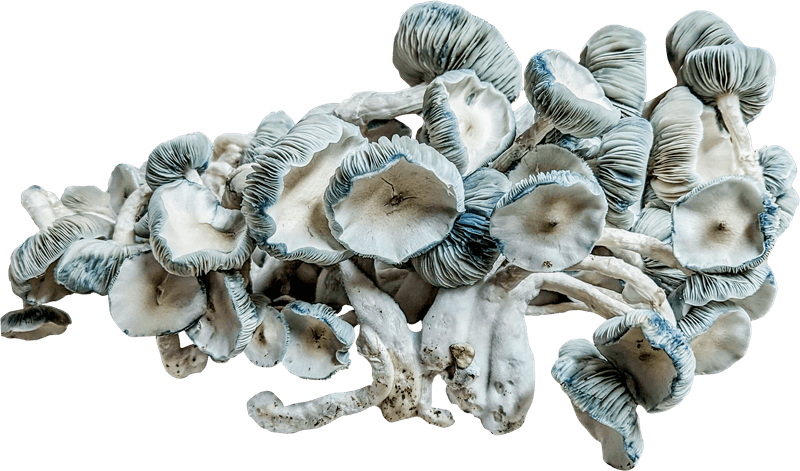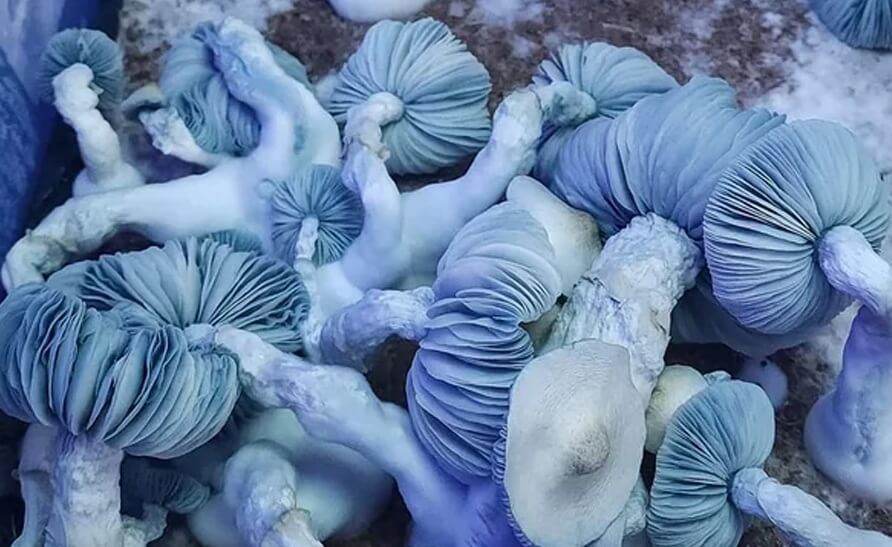
Jack Frost mushrooms stand out as a distinctive and highly sought-after strain in the mycology world, revered for their frost-like caps, striking cerulean hue, and potent psychedelic effects. This unique hybrid of True Albino Teacher and Albino Penis Envy shares some intriguing traits with the Enigma mushroom, making it both an exciting and rewarding strain to cultivate.
Jack Frost mushrooms exhibit strong mycelial resilience, producing dense fruiting bodies with thick stems and beautifully curled caps. Upon bruising, they reveal a deep blue coloration, an indicator of their high psilocybin concentration. Their slow yet robust growth cycle makes them ideal for cultivators seeking a potent and visually stunning variety.
Sought after for both scientific study and personal exploration, these mushrooms are valued for their unique characteristics and powerful effects. Their cultivation requires patience and precision, but the rewards are well worth the effort.
Here's an expert guide to understanding and successfully cultivating this remarkable mushroom.
Key Characteristics of Jack Frost Mushrooms
Genetic Lineage & Unique Traits
- Hybrid Origins: A cross between True Albino Teacher and Albino Penis Envy, combining their unique strengths.
- Cap Transformation: As they mature, their caps curl outward and take on a striking cerulean hue, making them visually distinctive.
- Dense Fruiting Bodies: Compared to other Psilocybe cubensis varieties, Jack Frost produces thick, robust stems and dense caps, which contribute to its slower growth but higher potency.
- Resilient Mycelium: The hybrid inherits strong colonization capabilities from True Albino Teacher, allowing it to thrive in a variety of substrates, including grain, manure-based compost, and coco coir mixes.
- High Psilocybin Content: Known for their potency, making them popular for research and recreational use. Some users report effects comparable to Penis Envy strains, with intense visual experiences and deep introspective journeys.
- Oxidation Reaction: Upon bruising or handling, the mycelium and fruiting bodies exhibit a vivid blue reaction, an indicator of high psilocybin concentration.
Cultivation Process
Growth Stages
Spore Syringe or Liquid Culture Inoculation
- Introduces Jack Frost genetics into a nutrient-rich substrate, initiating the growth process.
- Use a sterile spore syringe or liquid culture to inoculate a properly prepared medium such as an agar plate or sterilized grain jar.
- Liquid culture speeds up colonization by introducing live mycelium instead of spores, reducing contamination risk.
- Maintain incubation temperatures of 24-27°C (75-80°F) to encourage rapid germination and early mycelial growth.
Mycelium Colonization
- Under controlled conditions, the mycelium spreads vigorously, forming a strong foundation.
- Colonization typically takes 2-4 weeks, depending on temperature and substrate type.
- Shake or break up colonized grain at around 30-50% mycelial coverage to speed up even distribution.
Fruiting Conditions
- Once the mycelium fully colonizes the grain, transfer it to a bulk fruiting substrate such as pasteurized coco coir, vermiculite, and gypsum (CVG) or a manure-based mix.
- Spread the colonized grain evenly through the bulk substrate to encourage uniform mycelial expansion.
- Allow the bulk substrate to colonize fully, which can take an additional 7-14 days before introducing fruiting conditions. Some highly nutritious bulk substrates (e.g., manure-based mixes) may take longer.
- Precise humidity (85-90%) and temperature (21-24°C / 70-75°F) adjustments are crucial for optimal fruiting.
- Have adequate fresh air exchange (FAE) to prevent CO2 buildup, which encourages healthy fruiting body formation.
- Ensure the presence of microdroplets on the surface for proper hydration while avoiding pooling water.
- Monitor surface conditions closely; ideal moisture levels resemble tiny, evenly distributed water droplets without oversaturation.
- Maintain light exposure on a 12-hour light/dark cycle using LED or indirect natural light.
Ready to start cultivating Jack Frost? Get Jack Frost Spores →
Environmental Management
Humidity Control:
Maintain at 85-90% to ensure healthy development.
- Use a humidifier or misting system to keep high moisture levels without waterlogging the substrate.
- Maintain proper airflow to prevent excess humidity from causing bacterial or mold contamination.
Temperature Regulation:
Keep stable at 21-24°C (70-75°F) for ideal growth conditions.
- Avoid temperature fluctuations, which can stress the mycelium and slow down fruiting.
Light Exposure:
Minimal, providing indirect light to stimulate fruiting.
- A 12-hour light/dark cycle using LED or natural ambient light is sufficient for proper development.
Harvesting Jack Frost Mushrooms
Timing the Harvest
- Cap Development: Harvest when the caps curl outward and transition to their signature cerulean blue color.
- Visual Maturity: Look for the distinct color shift and cap curling as indicators of readiness.
Step-by-Step Harvesting Guide
Preparation
- Wear sterile gloves and use a sanitized scalpel.
Cutting
- Carefully sever mushrooms at the base to preserve the integrity of the mycelium. Sometimes the best way to do this would be a pinch at the base and twist method.
Drying & Storage
- Mushrooms must be cracker dry to prevent spoilage and degradation of potency.
- Use a dehydrator set to 45-50°C (113-122°F) for 12-24 hours to ensure thorough drying.
- If a dehydrator is unavailable, use a fan and desiccant chamber to remove residual moisture, though this method may take longer.
- Store in airtight containers with a desiccant packet to prevent moisture buildup.
- Keep in a cool, dark, and dry environment to maintain long-term potency.
When stored properly, dried mushrooms can retain their potency for 1 to 2 years, but optimal storage conditions can extend this even further. Here's what affects longevity:
Storage Conditions for Maximum Potency
- Airtight Containers: Use vacuum-sealed or airtight glass jars to prevent moisture exposure.
- Low Temperature: Store in a cool environment, ideally below 15°C (59°F), or refrigerate for longer shelf life.
- Minimal Light Exposure: Keep in a dark place to prevent light degradation.
- Desiccants: Use silica gel packs or food-grade desiccants inside storage containers to maintain dryness.
- Freezing: Some users report that properly dried mushrooms stored in the freezer can maintain potency for several years.
If mushrooms absorb moisture, they may degrade faster, lose potency, or become susceptible to mold. Always check for signs of spoilage before use.
Post-Harvest Handling
Cleaning and Sorting
- Cleaning: Use a soft brush to gently remove any substrate particles.
- Sorting: Classify by size and condition, discarding any compromised specimens.
Storage Techniques
- Moisture Control: Use airtight containers to prevent excess moisture.
- Optimal Conditions: Store in a cool, dry, and dark environment to maintain potency.
Troubleshooting & Optimization
Common Growth Issues & Solutions
Contamination:
Maintain strict sterility in all tools and procedures.
- Always sterilize syringes, scalpels, and any tools used in inoculation and substrate transfer.
- Work in a still air box (SAB) or laminar flow hood to reduce airborne contaminants.
- Use proper pasteurization or sterilization techniques for substrates and bulk mediums.
- Regularly inspect jars or bags for signs of mold, bacterial blotches, or unusual odors, discarding any contaminated specimens immediately.
Environmental Imbalances:
- Keep humidity at 85-90% using a misting system, humidifier, or perlite layer for proper moisture levels.
- Regularly monitor humidity, temperature, and light levels to prevent stunted growth.
- Avoid temperature fluctuations outside 21-24°C (70-75°F) to ensure healthy mycelial and fruiting body development.
- Provide gentle indirect light, as excessive exposure can cause drying, while too little light can hinder proper pin formation.
- Ensure adequate fresh air exchange (FAE) by adjusting vents, fanning, or running an air pump to prevent CO2 buildup, which can lead to elongated stems and weak fruiting bodies.
Slow or Stalled Growth:
- If colonization is slow or stalled, check for overly wet or dry substrate conditions and adjust moisture levels accordingly.
- Insufficient nutrients in the substrate may require supplementing with additional grain spawn or gypsum for mineral support.
- Lack of proper inoculation points can be resolved by shaking or breaking up colonized grains to distribute mycelium evenly.
Inconsistent Fruiting:
- If mushrooms fail to pin, check humidity levels and ensure the substrate surface is evenly hydrated.
- An excess of stagnant air can be resolved by increasing fresh air exchange to trigger pinning conditions.
- Adjust temperature and moisture to match optimal fruiting conditions, as improper conditions can delay or inhibit fruit formation.
- If fruiting remains inconsistent despite ideal conditions, consider using a cloned culture or agar-isolated genetics for better reliability.
Tips for Maximizing Yield
- Stable Conditions: Avoid fluctuations in environmental factors by maintaining consistent temperature, humidity, and airflow.
- Gentle Handling: Reduce physical damage during harvesting to preserve mycelium and ensure future flushes.
- Sterile Techniques: Implement thorough hygiene practices, including sterilizing all tools and working in a contamination-free environment.
- Proper Storage: Maintain correct storage conditions to extend viability and potency of both spores and harvested mushrooms.
- Substrate Optimization: Utilize a high-quality nutrient-dense substrate, such as a well-balanced mix of grain, coir, and gypsum, to promote strong mycelial growth and high yields.
- Fresh Air Exchange (FAE): Increase airflow without dropping humidity levels to enhance fruiting conditions and promote healthy mushroom development.
- Harvest Timing: Pick mushrooms at peak maturity to maximize potency and yield while ensuring continued flushes.
- Hydration Control: Mist lightly to keep the surface hydrated without over-saturating, preventing contamination and aborts.
- Multi-Flush Management: Rehydrate the substrate after each flush to encourage multiple rounds of fruiting and higher total yields.
- Compare Jack Frost with Other Albino Cubensis Varieties
Final Thoughts
Cultivating Jack Frost mushrooms is both a science and an art. With the right environmental controls, careful handling, and proper storage, cultivators can unlock the full potential of this visually stunning and highly potent strain. By following our guides, you can ensure a successful and rewarding cultivation experience. Happy growing!
Ready to begin your Jack Frost cultivation journey?
Get Jack Frost Spores →




